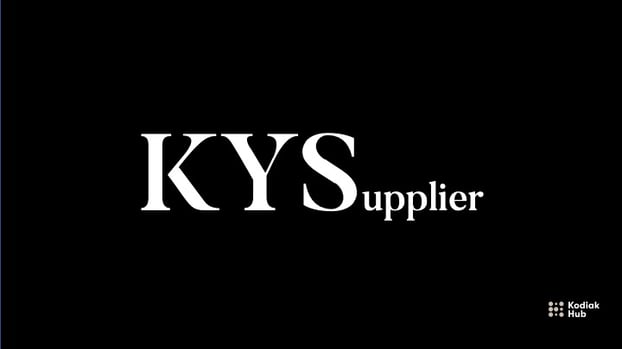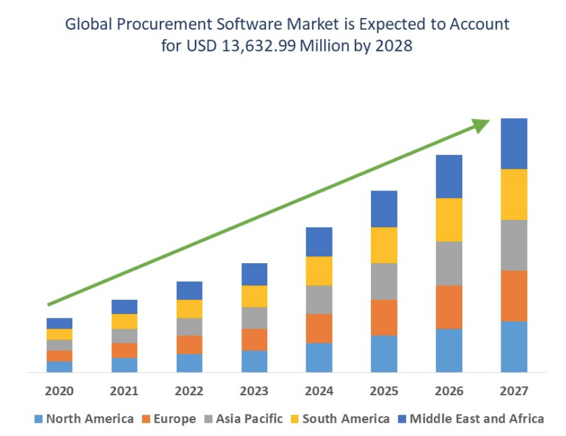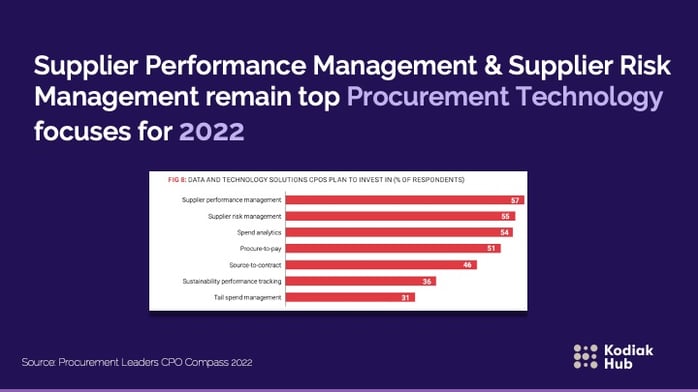This post started when my brother called me the other day to catch up.
Unfortunately, we don't get to see each other as much as we’d like considering I’ve been living in Europe since 2015 and he’s in the States.
My brother's & I's conversations can be about anything; ranging from what new restaurants we’ve been eating at to very detailed discussions about work projects; something I’m sure anyone with a long-distance friend or family member can relate to.
Respectively, my brother and I have careers in very different industries. My brother is an academic, a Ph.D., and works in administration at a university, and I work at a ProcureTech vendor, providing SaaS solutions to global procurement teams.
Both of our worlds are filled with business acronyms, but they’re rarely the same.
My days are filled with procurement terms and acronyms; S2C, P2P, ERP, CLM, SRM, SPM, SIM, AI, ML, BI, and the list goes on and on. Sometimes our professional terminology can easily slip into our personal conversations, and we just expect that the receiving party understands what we’re talking about.
“Our solution is typically integrated with broader ERP solutions to streamline SIM & performance evaluation because…” I was cut off by my brother.
“Whoa, whoa, whoa. You throw around procurement acronyms and industry terminology like rice at a wedding,” he said jokingly. But, I understood the subtext.
I can't blame him either.
Procurement isn’t an industry that everyone is overly familiar with. Procurement terminology isn’t always widely known or used.
With that said, I’m pretty darn proud to be a part of this ‘less-known’ community. I’m happy that I am familiar with the procurement 'vernacular'. And I'm guessing if you're reading this post, you are too. To get everyone up to speed with the latest and greatest topics being discussed in procurement I’ve chosen to assemble a list:
9 Procurement Terms Everyone Is Talking About
1. Supplier Performance Management
As defined by EPIQ;
Supplier Performance Management (SPM) is a business practice that is used to measure, analyze, and manage the performance of a supplier (EPIQ.com 2021).
According to Google Keyword planner (Looking at Europe’s 9 biggest markets & the United States), the search volume on the term Supplier Performance Management has increased 22% during the last 12mo. period.
This trend is reflected in recent procurement technology reports as well. As seen in the 2022 Procurement Leaders CPO Compass Survey (seen below), SPM tops the list of data & technology solutions that CPOs plan to invest in during 2022. Read more on 9 Benefits With Supplier Performance Management Software
2. Know Your Supplier
Know-Your-Customer (or KYC) is a well-established discipline utilized by financial institutions as a means of compliance and risk management.
The growing business importance of global supply chains is requiring procurement and sourcing teams to quickly get a thorough view of prospective and existing supplier relationships in a similar fashion as KYC practices.

The growing need for KYS often leads to deeper supplier governance, risk management, supply chain tier-mapping, and due diligence.
Luckily the abundance of publicly available data and market intelligence will make KYSupplier a whole lot simpler for procurement teams in 2022 and beyond.
Kodiak Hub’s platform recognizes this need and trend in the market, and therefore continues to expand upon our offerings of 3rd party market intelligence; natively integrated into our SRM platform’s interface. There’s no need to reinvent the wheel. Kodiak is relying on innovative market intelligence vendors & partners such as Modefinance, Membercheck & Webz.io to supplement our user’s KYS capabilities to follow up on Financial, Social & Environmental, and Geopolitical risks. Read more on this topic here in the article Do You Know Your Best Supplier.
Explore how you can improve your KYS with enhanced Supplier Onboarding & Assessments and robust Supply Chain Risk & Resilience Monitoring.
3. Lieferkettengesetz
Supply Chain Tier-Mapping, visibility & Transparency are 3 major pillars of procurement’s risk management strategies. It’s no secret, the urgent need for supply chain resilience is rooted in recent COVID-driven supply chain disruptions, and being reinforced by legislation.
Lieferkettengesetz “The Supply Chain Act” is a German Law that was passed in Feb 2021. This law is just a drop in the sea of legislation, currently and to come, that is enforcing a need for increased supply chain transparency and reporting. Lieferkettengesetz provides a concrete example of why supply chain tier-mapping will continue to be a focus for 2022 and beyond.
This act aims to enforce sustainable business practices within the broader value chains of large German organizations. Legal requirements of this act force companies to take responsibility for their global supply chains with enhanced due diligence, corporate governance and to have a means for reporting upon violations within various social, environmental and financial criteria.
The Supply Chain Act comes into force at the beginning of 2023 and affects companies with at least 3000 employees. Global organizations with complex supply chains are therefore the most affected. By 2024, companies with more than 1000 employees will also be expected to abide. Read more on The 5 Levels Of Supply Chain Transparency
4. Supplier Risk Management Systems
It’s no real shocker that supplier risk management and supply chain resilience are on the tips of tongues within global procurement teams.
According to Google Keyword planner (Looking at Europe’s 9 biggest markets & the United States), the search volume on the term Vendor (Supplier) Risk Management System has increased 80% during the last 12mo. period.
Obviously, procurement teams are looking to mitigate supplier-related risks by enhancing their ProcureTech ecosystems with new risk management solutions.
Referencing back to the graphic earlier in this post - SPM was the #1 area CPOs planned to invest in technology during 2022, and narrowly so. The 2nd area for planned investments in technology was listed as supplier risk management.
Supplier risk management is an incredibly broad topic and entails multiple sub-domains. The generic nature of this procurement term makes it difficult to understand what procurement teams are really looking for, but our hypothesis is that supplier risk management has a strong correlation with many of the other procurement terms & trends being highlighted in this article. Get deeper into this topic in the article 30+ Ways To Conquer Supplier Risk & Performance Management.
5. Supplier Diversity
Diversity in the supply chain is a hot-button issue in multinational companies and is quickly becoming a new staple within social governance and due diligence.
Taken from the 2022 CPO Compass survey by Procurement Leaders, it was reported that
“Almost four-fifths (79%) of CPOs indicate they will seek to improve supplier diversity and inclusion by tracking their expenditure with Tier-2 diverse suppliers in 2022, while 62% plan to revise supplier selection criteria to enable more diverse enterprises to win business”.
Increases in inclusive spending provides equal opportunity to businesses that are owned and/or operated by individual or group that is part of a traditionally underrepresented or underserved group, such as small-business enterprises (SBEs), minority-owned business enterprises (MBEs), woman-owned business enterprises (WBEs) and veteran-owned business (VOSBs) (CVM 2019). Check out this article on Supplier Diversity: One Small Step For Procurement, One Giant Leap For The World
6. ProcureTech
Step aside MarTech & FinTech… this global business technology market ain’t big enough for all of us!
All jokes aside, ProcureTech is a fast-growing software category that is quickly becoming the industry’s accepted term for digital procurement technology and applications.
The ProcureTech domain offers various solutions for purchasing automation, maintenance of supplier data, risk management, supply chain visibility, spend analysis, supply management and many other benefits, which have become increasingly important in today’s business landscape, and could subsequently support an expansion of the market during the coming years (MarketWatch 2020).

Data Bridge Market Research (Source of Image above) has projected that the global Procurement Software market will grow to an evaluation of 13.6B USD w/ a CAGR of 9.7% between 2021-2028.
Read more on how the industry outside of procurement has yet to latch on this new fast-growing category ProcureTech: A Fast-Growing Software Category No One Is Talking About
7. Procurement Analytics
Business Intelligence is ever-important in a world where data & information are amassing at an exponential rate. Simply put, a lot of procurement teams are drowning in information and starved for insights.
With this said, it’s not all that shocking that procurement teams are furiously finding ways to visualize supply chain data and enhance tactical & strategic procurement activities.
According to Google Keyword Planner (Looking at Europe’s 9 biggest markets & the United States), the search volume on the term Procurement Analytics has increased 49% during the last 12mo. period.
Alike supplier risk management, procurement analytics is a very broad term and could cover various subcategories of procurement intelligence. Some of the most important analytics for procurement teams to leverage are supplier performance, sustainability performance, spend, supply & warehousing, POs, supply chain risk, and market/category intelligence.
We dig a little bit deeper into this topic in Analytics: Procurements new best friend
8. Supplier Relationship Management Software
Supplier Relationship Management (SRM) can be complex.
Supplier Relationship Management software can make things a little bit easier.
Sales & Marketing teams have reaped the benefits of Customer Relationship Management (CRM) solutions & Marketing Automation for the past 15-20 years. All the while, procurement & sourcing teams have been left to fend for themselves, and forge their own way forward, with homegrown solutions; often using a mix of Microsoft tools to address supplier management needs.
According to Google Keyword planner (Looking at Europe’s 9 biggest markets & the United States), the search volume on the term Supplier Relationship Management software has increased 52% during the last 12mo. period.
This is a clear signal... Procurement teams are fed up with their excel spreadsheets and are ready to adopt modern SRM software.
Learn about the 5 Advantages With Supplier Relationship Management Software.
9. Supplier & Vendor Due Diligence
There’s nothing sexy about Supplier Due Diligence.
Governing a supplier base requires procurement teams to put in the hard yards, and engage with the many tiers of a global supplier network. At the same time, due diligence is a necessary activity to ensure broader business initiatives are heading in the right direction; for example, sustainability & ESG initiatives. Read more on Why Your Company Needs ESG Reporting Software to Safeguard Future Risks
According to Google Keyword planner (Looking at Europe’s 9 biggest markets & the United States), the search volume on the term Supplier due diligence (and due diligence checklists) software has increased almost 80% during the last 12mo. period.
A lack of compliance among suppliers can cause loss of brand value which in return may cause significant loss of shareholder and equity value. Studied cases at Kodiak show between 1-5 % loss of brand exposure to a non-compliant supply chain. Focusing supplier due diligence on a wider scope of sourcing criteria can significantly reduce the risk of supply chain oversight.













